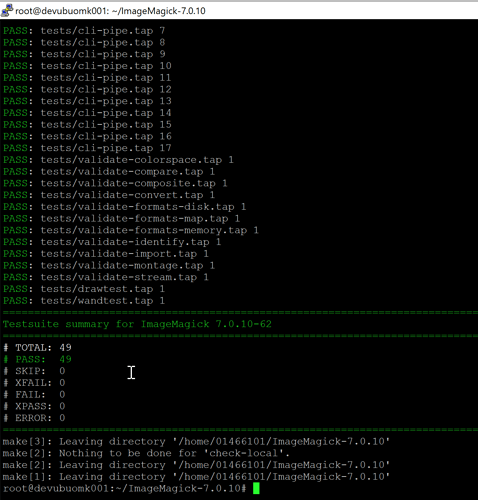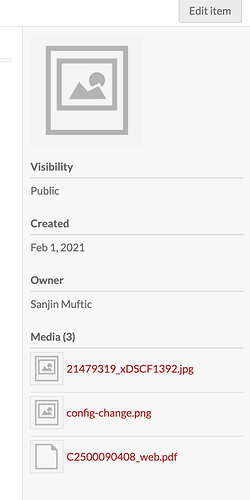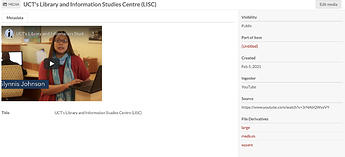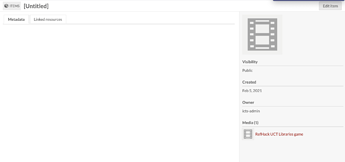Hello again,
So we went through a did what you suggested @jflatnes. From our IT department “ghost script in installed, and ImageMagick is now configured to allow PDF generation in its policy.xml file.” We also ran the command on imagemagick and got the result below.
However, when adding new items, we are still not getting a thumbnail and we are getting the error
Command "/usr/local/bin/convert -density 150 '/data/www/omeka-s/sideload/C2500090408_web.pdf[0]' -auto-orient -background white +repage -alpha remove -thumbnail '800x800>' '/tmp/omekaGJ4UDT.jpg'" failed with status code 1.
If as you said, we had it working before, I wonder if change the code in the config file so that instead of
'thumbnailer_options' => [
'imagemagick_dir' => '/usr/local/bin',
],
we go back to
'thumbnailer_options' => [
'imagemagick_dir' => null,
],
if that would work, but from reading documentation that doesn’t make sense to me, for how does Omeka know the path?
The result of our /usr/local/bin/convert -list format is:
{\rtf1\ansi\ansicpg1252\cocoartf2513
\cocoatextscaling0\cocoaplatform0{\fonttbl\f0\fswiss\fcharset0 Helvetica;}
{\colortbl;\red255\green255\blue255;}
{\*\expandedcolortbl;;}
\paperw11900\paperh16840\margl1440\margr1440\vieww10800\viewh8400\viewkind0
\pard\tx566\tx1133\tx1700\tx2267\tx2834\tx3401\tx3968\tx4535\tx5102\tx5669\tx6236\tx6803\pardirnatural\partightenfactor0
\f0\fs24 \cf0 root@devubuomk001:~/ImageMagick-7.0.10# /usr/local/bin/convert -list format\
Format Mode Description\
-------------------------------------------------------------------------------\
3FR r-- Hasselblad CFV/H3D39II\
3G2 r-- Media Container\
3GP r-- Media Container\
A* rw+ Raw alpha samples\
AAI* rw+ AAI Dune image\
AI rw- Adobe Illustrator CS2\
APNG rw+ Animated Portable Network Graphics\
ART* rw- PFS: 1st Publisher Clip Art\
ARW r-- Sony Alpha Raw Image Format\
ASHLAR* -w+ Image sequence laid out in continuous irregular courses\
AVI r-- Microsoft Audio/Visual Interleaved\
AVS* rw+ AVS X image\
B* rw+ Raw blue samples\
BGR* rw+ Raw blue, green, and red samples\
BGRA* rw+ Raw blue, green, red, and alpha samples\
BGRO* rw+ Raw blue, green, red, and opacity samples\
BMP* rw- Microsoft Windows bitmap image\
BMP2* rw- Microsoft Windows bitmap image (V2)\
BMP3* rw- Microsoft Windows bitmap image (V3)\
BRF* -w- BRF ASCII Braille format\
C* rw+ Raw cyan samples\
CAL* r-- Continuous Acquisition and Life-cycle Support Type 1\
Specified in MIL-R-28002 and MIL-PRF-28002\
CALS* r-- Continuous Acquisition and Life-cycle Support Type 1\
Specified in MIL-R-28002 and MIL-PRF-28002\
CANVAS* r-- Constant image uniform color\
CAPTION* r-- Caption\
CIN* rw- Cineon Image File\
CIP* -w- Cisco IP phone image format\
CLIP* rw+ Image Clip Mask\
CMYK* rw+ Raw cyan, magenta, yellow, and black samples\
CMYKA* rw+ Raw cyan, magenta, yellow, black, and alpha samples\
CR2 r-- Canon Digital Camera Raw Image Format\
CR3 r-- Canon Digital Camera Raw Image Format\
CRW r-- Canon Digital Camera Raw Image Format\
CUBE* r-- Cube LUT\
CUR* rw- Microsoft icon\
CUT* r-- DR Halo\
DATA* rw+ Base64-encoded inline images\
DCM* r-- Digital Imaging and Communications in Medicine image\
DICOM is used by the medical community for images like X-rays. The\
specification, "Digital Imaging and Communications in Medicine\
(DICOM)", is available at http://medical.nema.org/. In particular,\
see part 5 which describes the image encoding (RLE, JPEG, JPEG-LS),\
and supplement 61 which adds JPEG-2000 encoding.\
DCR r-- Kodak Digital Camera Raw Image File\
DCRAW r-- Raw Photo Decoder (dcraw)\
DCX* rw+ ZSoft IBM PC multi-page Paintbrush\
DDS* rw+ Microsoft DirectDraw Surface\
DNG r-- Digital Negative\
DPX* rw- SMPTE 268M-2003 (DPX 2.0)\
Digital Moving Picture Exchange Bitmap, Version 2.0.\
See SMPTE 268M-2003 specification at http://www.smtpe.org\
\
DXT1* rw+ Microsoft DirectDraw Surface\
DXT5* rw+ Microsoft DirectDraw Surface\
EPDF rw- Encapsulated Portable Document Format\
EPI rw- Encapsulated PostScript Interchange format\
EPS rw- Encapsulated PostScript\
EPS2 -w- Level II Encapsulated PostScript\
EPS3 -w+ Level III Encapsulated PostScript\
EPSF rw- Encapsulated PostScript\
EPSI rw- Encapsulated PostScript Interchange format\
ERF r-- Epson RAW Format\
FARBFELD* rw- Farbfeld\
FAX* rw+ Group 3 FAX\
FAX machines use non-square pixels which are 1.5 times wider than\
they are tall but computer displays use square pixels, therefore\
FAX images may appear to be narrow unless they are explicitly\
resized using a geometry of "150x100%".\
\
FF* rw- Farbfeld\
FILE* r-- Uniform Resource Locator (file://)\
FITS* rw- Flexible Image Transport System\
FL32* rw- FilmLight\
FLV rw+ Flash Video Stream\
FRACTAL* r-- Plasma fractal image\
FTP* --- Uniform Resource Locator (ftp://)\
FTS* rw- Flexible Image Transport System\
G* rw+ Raw green samples\
G3* rw- Group 3 FAX\
G4* rw- Group 4 FAX\
GIF* rw+ CompuServe graphics interchange format\
GIF87* rw- CompuServe graphics interchange format (version 87a)\
GRADIENT* r-- Gradual linear passing from one shade to another\
GRAY* rw+ Raw gray samples\
GRAYA* rw+ Raw gray and alpha samples\
HALD* r-- Identity Hald color lookup table image\
HDR* rw+ Radiance RGBE image format\
HISTOGRAM* -w- Histogram of the image\
HRZ* rw- Slow Scan TeleVision\
HTM* -w- Hypertext Markup Language and a client-side image map\
HTML* -w- Hypertext Markup Language and a client-side image map\
HTTP* --- Uniform Resource Locator (http://)\
HTTPS* r-- Uniform Resource Locator (https://)\
ICB* rw- Truevision Targa image\
ICO* rw+ Microsoft icon\
ICON* rw- Microsoft icon\
IIQ r-- Phase One Raw Image Format\
INFO -w+ The image format and characteristics\
INLINE* rw+ Base64-encoded inline images\
IPL* rw+ IPL Image Sequence\
ISOBRL* -w- ISO/TR 11548-1 format\
ISOBRL6* -w- ISO/TR 11548-1 format 6dot\
JNX* r-- Garmin tile format\
JSON -w+ The image format and characteristics\
K* rw+ Raw black samples\
K25 r-- Kodak Digital Camera Raw Image Format\
KDC r-- Kodak Digital Camera Raw Image Format\
LABEL* r-- Image label\
M* rw+ Raw magenta samples\
M2V rw+ MPEG Video Stream\
M4V rw+ Raw VIDEO-4 Video\
MAC* r-- MAC Paint\
MAP* rw- Colormap intensities and indices\
MASK* rw+ Image Clip Mask\
MAT rw+ MATLAB level 5 image format\
MATTE* -w+ MATTE format\
MEF r-- Mamiya Raw Image File\
MIFF* rw+ Magick Image File Format\
MKV rw+ Multimedia Container\
MONO* rw- Raw bi-level bitmap\
MOV rw+ MPEG Video Stream\
MP4 rw+ VIDEO-4 Video Stream\
MPC* rw+ Magick Persistent Cache image format\
MPEG rw+ MPEG Video Stream\
MPG rw+ MPEG Video Stream\
MRW r-- Sony (Minolta) Raw Image File\
MSL* --- Magick Scripting Language\
MSVG* -w+ ImageMagick's own SVG internal renderer\
MTV* rw+ MTV Raytracing image format\
MVG* rw- Magick Vector Graphics\
NEF r-- Nikon Digital SLR Camera Raw Image File\
NRW r-- Nikon Digital SLR Camera Raw Image File\
NULL* rw- Constant image of uniform color\
O* rw+ Raw opacity samples\
ORA --- OpenRaster format\
ORF r-- Olympus Digital Camera Raw Image File\
OTB* rw- On-the-air bitmap\
PAL* rw- 16bit/pixel interleaved YUV\
PALM* rw+ Palm pixmap\
PAM* rw+ Common 2-dimensional bitmap format\
PANGO* --- Pango Markup Language\
PATTERN* r-- Predefined pattern\
PBM* rw+ Portable bitmap format (black and white)\
PCD* rw- Photo CD\
PCDS* rw- Photo CD\
PCL rw+ Printer Control Language\
PCT* rw- Apple Macintosh QuickDraw/PICT\
PCX* rw- ZSoft IBM PC Paintbrush\
PDB* rw+ Palm Database ImageViewer Format\
PDF rw+ Portable Document Format\
PDFA rw+ Portable Document Archive Format\
PEF r-- Pentax Electronic File\
PES* r-- Embrid Embroidery Format\
PFM* rw+ Portable float format\
PGM* rw+ Portable graymap format (gray scale)\
PGX* rw- JPEG 2000 uncompressed format\
PHM* rw+ Portable half float format\
PICON* rw- Personal Icon\
PICT* rw- Apple Macintosh QuickDraw/PICT\
PIX* r-- Alias/Wavefront RLE image format\
PLASMA* r-- Plasma fractal image\
PNM* rw+ Portable anymap\
POCKETMOD rw+ Pocketmod Personal Organizer\
PPM* rw+ Portable pixmap format (color)\
PS rw+ PostScript\
PS2 -w+ Level II PostScript\
PS3 -w+ Level III PostScript\
PSB* rw+ Adobe Large Document Format\
PSD* rw+ Adobe Photoshop bitmap\
PWP* r-- Seattle Film Works\
R* rw+ Raw red samples\
RADIAL-GRADIENT* r-- Gradual radial passing from one shade to another\
RAF r-- Fuji CCD-RAW Graphic File\
RAS* rw+ SUN Rasterfile\
RAW r-- Raw\
RGB* rw+ Raw red, green, and blue samples\
RGB565* r-- Raw red, green, blue samples in 565 format\
RGBA* rw+ Raw red, green, blue, and alpha samples\
RGBO* rw+ Raw red, green, blue, and opacity samples\
RGF* rw- LEGO Mindstorms EV3 Robot Graphic Format (black and white)\
RLA* r-- Alias/Wavefront image\
RLE* r-- Utah Run length encoded image\
RMF r-- Raw Media Format\
RW2 r-- Panasonic Lumix Raw Image\
SCR* r-- ZX-Spectrum SCREEN$\
SCREENSHOT* r-- Screen shot\
SCT* r-- Scitex HandShake\
SFW* r-- Seattle Film Works\
SGI* rw+ Irix RGB image\
SHTML* -w- Hypertext Markup Language and a client-side image map\
SIX* rw- DEC SIXEL Graphics Format\
SIXEL* rw- DEC SIXEL Graphics Format\
SPARSE-COLOR* -w+ Sparse Color\
SR2 r-- Sony Raw Format 2\
SRF r-- Sony Raw Format\
STEGANO* r-- Steganographic image\
SUN* rw+ SUN Rasterfile\
SVG* rw+ Scalable Vector Graphics\
SVGZ* -w+ Compressed Scalable Vector Graphics\
TEXT* r-- Text\
TGA* rw- Truevision Targa image\
THUMBNAIL* -w+ EXIF Profile Thumbnail\
TILE* r-- Tile image with a texture\
TIM* r-- PSX TIM\
TM2* r-- PS2 TIM2\
TXT* rw+ Text\
UBRL* -w- Unicode Text format\
UBRL6* -w- Unicode Text format 6dot\
UIL* -w- X-Motif UIL table\
UYVY* rw- 16bit/pixel interleaved YUV\
VDA* rw- Truevision Targa image\
VICAR* rw- VICAR rasterfile format\
VID* rw+ Visual Image Directory\
VIFF* rw+ Khoros Visualization image\
VIPS* rw+ VIPS image\
VST* rw- Truevision Targa image\
WBMP* rw- Wireless Bitmap (level 0) image\
WEBM rw+ Open Web Media\
WMV rw+ Windows Media Video\
WPG* r-- Word Perfect Graphics\
X3F r-- Sigma Camera RAW Picture File\
XBM* rw- X Windows system bitmap (black and white)\
XC* r-- Constant image uniform color\
XCF* r-- GIMP image\
XPM* rw- X Windows system pixmap (color)\
XPS r-- Microsoft XML Paper Specification\
XV* rw+ Khoros Visualization image\
Y* rw+ Raw yellow samples\
YAML -w+ The image format and characteristics\
YCbCr* rw+ Raw Y, Cb, and Cr samples\
YCbCrA* rw+ Raw Y, Cb, Cr, and alpha samples\
YUV* rw- CCIR 601 4:1:1 or 4:2:2\
\
* native blob support\
r read support\
w write support\
+ support for multiple images\
root@devubuomk001:~/ImageMagick-7.0.10#\
}
Thanks for your help.



